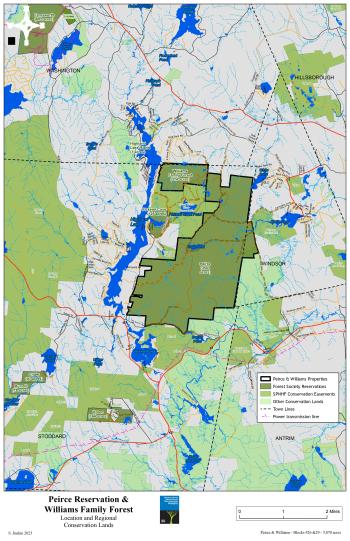Project Area
 The Peirce Reservation is a 3,870-acre reservation located in southwest New Hampshire. It is predominantly encumbered by a restrictive forever wild conservation easement with about 850 acres of the property designated for active forest habitat management.
The Peirce Reservation is a 3,870-acre reservation located in southwest New Hampshire. It is predominantly encumbered by a restrictive forever wild conservation easement with about 850 acres of the property designated for active forest habitat management. The Wright Pasture (Stand 14) comprises 142 acres in the southern end of the property and is one of those active management zones. The stand is dominated by hemlock-beech-northern hardwood and sugar maple-beech-yellow birch natural communities. The terrain slopes south-southwesterly. Soils in the stand are a mixture of Tunbridge, Berkshire, and Lyman fine sandy loams, with plenty of stones, boulders, and rocky outcrops. These soils are a mixture of Group IA (productive, rich, moist soils) and Group IIA (soils limited by slope or terrain). Hardwoods are dominant throughout, making up 73% of basal area, but there are just enough softwoods to consider this a mixedwood stand.
As the name indicates, this area is spotted with cellar holes and stone walls indicative of former settled land abandoned around the turn of the 20th century. The forests in the area have seen great disturbances since abandonment, including the hurricane of 1938 which left behind the fuels that fed the great Stoddard/Marlow fire of 1941. The fire burned through much of the areas in and surrounding this stand.
Management Goals
Specific management goals and objectives for the project area include:
Encourage ash seedling recruitment and release young ash trees to recoup losses from emerald ash borer mortality following the 2022 ash seed year
Identify areas suitable for white ash regeneration (i.e., areas with mature ash or advance ash regeneration)
Regenerate white ash wherever feasible including using regeneration cuts to release existing ash advance regeneration
Increase representation of young forest area to complement the surrounding acres of older forest and land under “forever wild” easement designation
Use timber harvests (patch cuts, shelterwood, and seed tree cuts) to establish 50+ acres of young forest
Maintain or increase existing tree species diversity to buffer impacts from pests and pathogens
Retain all 12 tree species recorded during 2022 inventory during timber harvest, even if they are of poor quality
Focus subsequent harvest entries on enhancing suitable growing conditions and vigor of all species retained and/or recruited (0-20 years)
Conduct thinnings to improve tree vigor and health and to favor tree species present in low numbers
Climate Change Impacts
Challenges and Opportunities
Challenges
Opportunities
Adaptation Actions
Project participants used the Adaptation Workbook to develop several adaptation actions for this project, including:
9.7. Introduce species that are expected to be adapted to future conditions.
2.1. Maintain or improve the ability of forests to resist pests and pathogens.
3.3. Alter forest structure to reduce severity or extent of wind and ice damage.
10.1 Promptly revegetate sites after disturbance.





